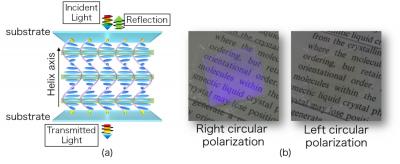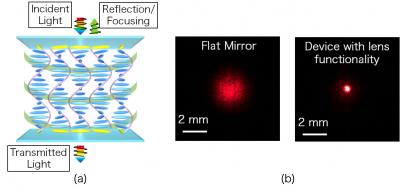Researchers at Osaka University developed a technology to control the light wavefront reflected from a cholesteric liquid crystal - a liquid crystal phase with a helical structure. Although known for their ability to Bragg-reflect light, cholesteric liquid crystals could only be used as flat mirrors, reflecting light at the same angle as the incident angle. The new technology enables planar optical components to be made with functionality by design, contributing to the miniaturization of catoptrics devices.
The cholesteric liquid crystal is a liquid crystal phase in which the constituent rod-like molecules spontaneously form a helical structure (Fig. 1). Owing to its structure, cholesteric liquid crystals exhibit Bragg-reflection for circularly polarized light with the same polarization handedness as the helix, over a wavelength range determined by the refractive index and the helical pitch. Their characteristic optical properties, as well as the fact that structure is formed by self-organization, have made cholesteric liquid crystals attractive for use as circular polarizers, light reflectors, and electronic papers. However, their ability to function only as a flat dielectric mirror in which light must follow the law of reflection posed a limit on the performance they could achieve, and hence usage of devices based on these materials.
 |
|
Schematic illustration (left) and photos (right) of a standard cholesteric liquid crystal device. The green bars in the left figure are guides indicating positions with the same helix phase. Cholesteric liquid crystals reflect circularly polarized light with the same handedness as the helical structure and with wavelength fulfilling the Bragg condition (refractive index a helical pitch). In the right figure, purple light with right circular polarization is reflected. (All images courtesy of Osaka University) |
Hiroyuki Yoshida, Assistant Professor, Junji Kobashi, a graduate student, and Masanori Ozaki, Professor at Graduate School of Engineering, Osaka University discovered that the optical phase reflected from a cholesteric liquid crystal varied depending on the phase of the helical structure. The distribution of optical phase (also known as the wavefront) determines how the light propagates; for example, light propagating along a straight line has a flat profile, whereas light that converges has a curved (parabolic) profile. On the other hand, the helix phase defines the relative orientation of the helical structure at a particular position in space, and can easily be controlled by defining the orientation of the liquid crystal molecules on a substrate. Therefore, by patterning the orientational easy axis in a standard, slab-like cholesteric liquid crystal device, the reflected wavefront can be designed arbitrarily. Figure 2 illustrates a planar lens device based on this concept; the parabolic distribution of the helix phase converts an incident planar wavefront to a parabolic profile that converges at a single point. The device shows high circular polarization selectivity even when the helix phase is patterned; the technology thus provides a platform to develop unique optical devices that can be tuned from being fully reflective to transmissive, depending on the incident polarization.
This research was featured in the electronic version of Nature Photonics on Monday, April 11, 2016.
 |
|
Schematic illustration of a cholesteric liquid crystal device with lens functionality (left) and photos of reflected beam spots (right). The parabolic profile of the helix phase converts the incident plane wave to a converging beam, which focuses to a spot. |













